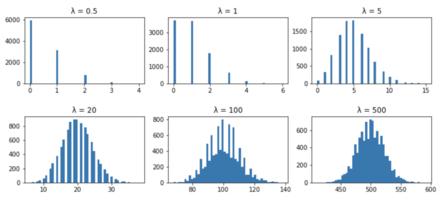veneratifer
New member
- Joined
- Dec 29, 2022
- Messages
- 2
What is the limit (if any exists) of this formula? Is it 1/2?
[math]\lim_{\lambda\rightarrow\infty}\sum_{k=\lambda}^{\infty}\frac{\lambda^{k}e^{-\lambda}}{k!}[/math]Your summation doesn't make much sense.What is the limit (if any exists) of this formula? Is it 1/2?[math]\lim_{\lambda\rightarrow\infty}\sum_{k=\lambda}^{\infty}\frac{\lambda^{k}e^{-\lambda}}{k!}[/math]
Thank you for reply !Your summation doesn't make much sense.
1) [imath]\lambda[/imath] is a constant parameter, you can't take the limit.
2) For the lower bound of the summation, k normally start at 0. Can you explain why is it starting at [imath]\lambda[/imath]?
Essentially you're looking for the probability of the random variable being greater than or equal to its mean i.e. [imath]\lambda[/imath]. Typically, we simply write [imath]\Pr(X\ge \lambda | \lambda = c)[/imath] , where [imath]c[/imath] is some positive real number.Thank you for reply !
Probably you are right - my summation have no sense, but I don't know how to write this formally correct. My idea is as follow:
there is a poisson distribution of some event, I want to calculate probability that event occurs [imath]\geq\lambda[/imath] times, so I sum PMF from [imath]\lambda[/imath] to [imath]\infty[/imath] (the reason why lower bound of the summation start at [imath]\lambda[/imath])

import seaborn as sns
from matplotlib import pyplot as plt
import numpy as np
import math
plt.close('all')
lambdas = [.5,1,5,20,100,500] #Change different values of lambda here
f, ax = plt.subplots(2,3, figsize = (12,5))
for i,rate in enumerate(lambdas):
plt.subplot(2,3,i+1)
data = np.random.poisson(rate, size=10000)
plt.hist(data, bins=50, linewidth=1,histtype = 'stepfilled')
plt.title('\u03BB = '+ str(rate))
plt.subplots_adjust(hspace=0.5)
plt.show()